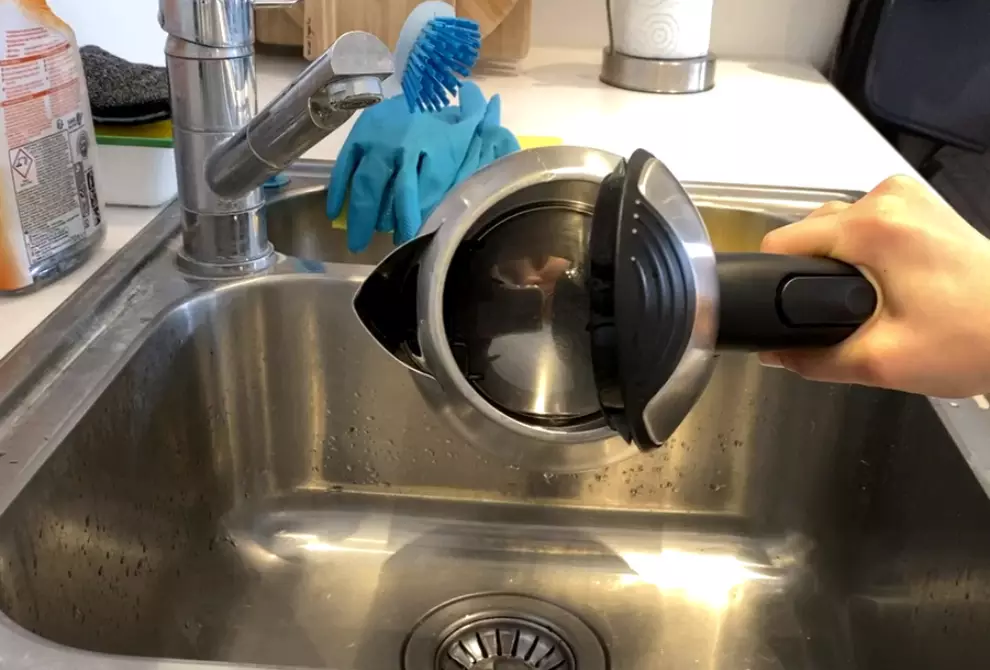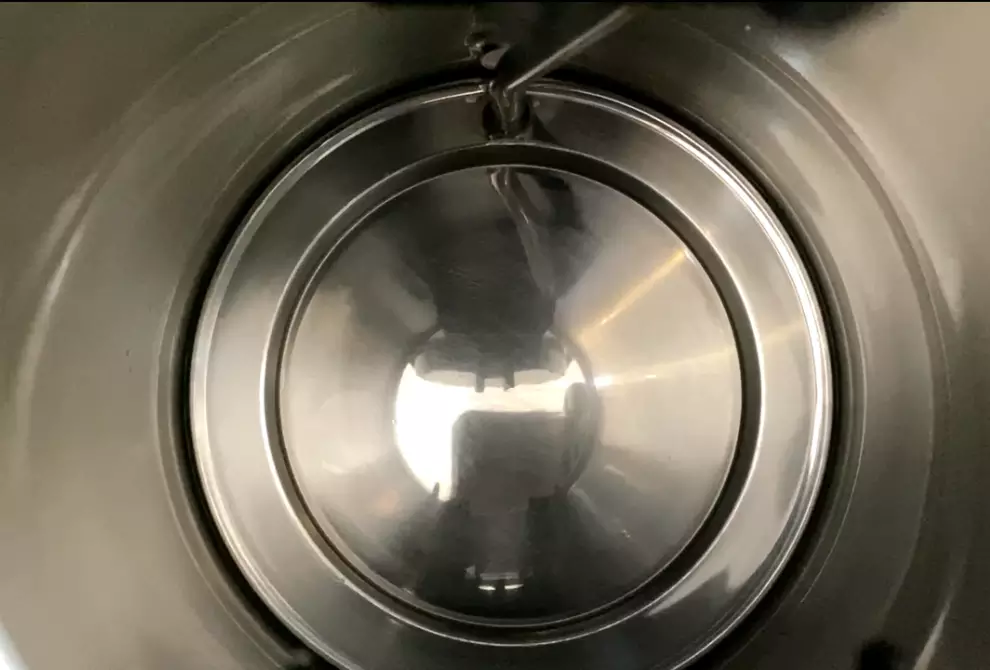In the hustle and bustle of our daily lives, the trusty electric kettle often stands as a steadfast ally, faithfully delivering hot water at the push of a button. But have you ever thought about the issue of “How Do You Clean The Inside Of An Electric Kettle?” We might not think to ask this question until we find strange residue or a faint odor inside.
But don’t worry—this problem has an easier solution than you might expect. This article will take you on a journey into the realm of electric kettle maintenance and reveal the tricks to keeping the inside spotless. So let’s start a kettle renaissance and grab our descaling remedies!
How to clean a kettle using vinegar?
Here’s a step-by-step guide on how to clean inside of kettle using vinegar:
Materials you’ll need:
- White vinegar
- Water
- A scrub brush or soft cloth
- Prepare the Solution: Fill the kettle halfway with equal parts water and white vinegar. For a small kettle, half a cup of each should suffice. Adjust the amounts accordingly for larger kettles.
- Boil the Solution: Now, it’s time to clean the inside of the kettle using vinegar. Place the kettle for heating and bring the vinegar-water mixture to a boil. Allow it to boil for a few minutes.
- Let it Sit: Turn off the kettle and unplug it from the power source. Allow the solution to sit inside the kettle for at least 15–20 minutes. This gives the vinegar time to break down the limescale and mineral deposits.
- Scrub if Necessary: After soaking, use a scrub brush or a soft cloth to gently scrub the interior of the kettle. Be sure not to use anything abrasive that could scratch the kettle’s surface.
- Rinse Thoroughly: Empty the vinegar solution from the kettle and rinse it thoroughly with clean water several times. Ensure that no vinegar residue remains.
- Dry and Reassemble: Once the kettle is clean and free from any vinegar or lemon residue, dry it thoroughly with a clean, dry cloth. Reassemble any removable parts, such as the kettle lid and filter.

How to clean kettle using Citric Acid
Here’s a step-by-step guide on How do you clean the inside of an electric kettle using citric acid powder:
Materials you’ll need:
- Citric acid powder
- Water
- A scrub brush or soft cloth
- Prepare the Citric Acid Solution: To clean the inside of the kettle effectively using citric acid, start by making a solution. Mix 1 to 2 tablespoons of citric acid powder with enough water to fill the kettle about halfway.
- Dissolve Citric Acid: Stir the citric acid powder and water mixture until the citric acid is completely dissolved.
- Pour the Solution: Pour the citric acid solution into the kettle, ensuring it covers the areas with limescale or mineral deposits.
- Boil the Solution: Turn on the kettle and bring the citric acid solution to a boil. Allow it to boil for a few minutes, and you may observe the scaling or deposits starting to dissolve.
- Let it Sit: Turn off the kettle and unplug it from the power source. Allow the citric acid solution to sit inside the kettle for about 15–20 minutes. This gives the citric acid time to break down the limescale and mineral deposits.
- Scrub if Necessary: After the solution has soaked, use a scrub brush or a soft cloth to gently scrub the interior of the kettle. This will help remove any remaining residue.
- Rinse Thoroughly: Empty the citric acid solution from the kettle and rinse it thoroughly with clean water several times. Ensure that no citric acid residue remains.
- Dry and Reassemble: Once the kettle is clean and free from citric acid residue, dry it thoroughly with a clean, dry cloth. Reassemble any removable parts, such as the kettle lid and filter.
How to clean an electric kettle with lemon
Cleaning an electric kettle with lemon is a natural and effective method that not only removes limescale and mineral deposits but also leaves a refreshing scent. Here’s a step-by-step guide on how to clean an electric kettle with lemon:
Materials You’ll Need:
- Lemons (2-3, depending on size)
- Water
- A scrub brush or soft cloth
- Prepare the Lemons: Start by gathering 2-3 fresh lemons. Cut them into slices or halves, removing any seeds.
- Fill the Kettle: the electric kettle with water, enough to cover the areas inside that need cleaning. The exact amount of water may vary depending on the kettle’s size and the severity of scaling.
- Add Lemon Slices: Place the lemon slices or halves into the kettle with the water. You can also squeeze the lemon juice directly into the water if you prefer.
- Boil the Lemon-Water Solution: Turn on the kettle and bring the lemon-water solution to a boil. Allow it to boil for a few minutes, and you may notice the scaling or deposits starting to dissolve.
- Let it Sit: Turn off the kettle and unplug it from the power source. Allow the lemon-water solution to sit inside the kettle for about 15-20 minutes. This gives the lemon’s natural acidity time to break down the limescale and mineral deposits.
- Scrub if Necessary: After the solution has soaked, use a scrub brush or a soft cloth to gently scrub the interior of the kettle. This will help remove any remaining residue.
- Rinse Thoroughly: Empty the lemon-water solution from the kettle and rinse it thoroughly with clean water several times. Ensure that no lemon residue remains.
- Dry and Reassemble: Once the kettle is clean and free from lemon residue, dry it thoroughly with a clean, dry cloth. Reassemble any removable parts, such as the kettle lid and filter.

How to clean kettle with baking soda
Here is the best guide on how to clean the inside of a kettle using baking soda:
Materials you’ll need:
- Baking soda
- Water
- A scrub brush or soft cloth
- Prepare the Baking Soda Solution: Start by cleaning the inside of the kettle with baking soda. Mix 2–3 tablespoons of baking soda with water to fill the kettle about halfway.
- Dissolve Baking Soda: Stir the baking soda and water mixture until the baking soda is completely dissolved.
- Pour the Solution: Pour the baking soda solution into the kettle, ensuring it covers the areas with limescale or mineral deposits.
- Boil the Solution: Turn on the kettle and bring the baking soda solution to a boil. Allow it to boil for a few minutes, and you may observe the scaling or deposits starting to dissolve.
- Let it Sit: Turn off the kettle and unplug it from the power source. Allow the baking soda solution to sit inside the kettle for about 15–20 minutes. This gives the baking soda time to break down the limescale and mineral deposits.
- Scrub if Necessary: After the solution has soaked, use a scrub brush or a soft cloth to gently scrub the interior of the kettle. This will help remove any remaining residue.
- Rinse Thoroughly 7. Empty the baking soda solution from the kettle and rinse it thoroughly with clean water several times. Ensure that no baking soda residue remains.
- Dry and Reassemble: Once the kettle is clean and free from baking soda residue, dry it thoroughly with a clean, dry cloth. Reassemble any removable parts, such as the kettle lid and filter.
- Test with Plain Water: Before using the kettle to boil water for beverages, boil a full kettle of plain water once or twice to ensure there are no traces of baking soda left.
Conclusion
Cleaning the inside of an electric kettle is a simple and essential task to ensure the longevity of the appliance and maintain the quality of the beverages it produces. You can keep your electric kettle in top form by regularly descaling using a vinegar-water solution, citric acid powder, lemon, or baking soda.
To ensure that your hot beverages taste the best, don’t forget to rinse them properly to get rid of any residue and odor. In addition, regular cleaning prevents the growth of mineral deposits that might affect the water’s quality while improving the kettle’s efficiency and encouraging a healthy drinking experience. Cleaning your electric kettle regularly can help maintain its effectiveness and guarantee that your beverages are always delicious.
Leave a Reply